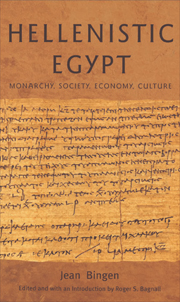Book contents
- Frontmatter
- Contents
- Original Sources of Chapters
- List of illustrations
- Glossary
- Maps
- Foreword
- Introduction: Jean Bingen and the currents of Ptolemaic history
- Part I The Monarchy
- 1 Ptolemy I and the quest for legitimacy
- 2 Ptolemy III and Philae: snapshot of a reign, a temple, and a cult
- 3 Cleopatra, the diadem and the image
- 4 Cleopatra VII Philopatris
- 5 The dynastic politics of Cleopatra VII
- Part II The Greeks
- Part III The Royal Economy
- Part IV Greeks and Egyptians
- Conclusion
- Bibliography
- General index
- Index of passages discussed
- HELLENISTIC CULTURE AND SOCIETY
2 - Ptolemy III and Philae: snapshot of a reign, a temple, and a cult
from Part I - The Monarchy
- Frontmatter
- Contents
- Original Sources of Chapters
- List of illustrations
- Glossary
- Maps
- Foreword
- Introduction: Jean Bingen and the currents of Ptolemaic history
- Part I The Monarchy
- 1 Ptolemy I and the quest for legitimacy
- 2 Ptolemy III and Philae: snapshot of a reign, a temple, and a cult
- 3 Cleopatra, the diadem and the image
- 4 Cleopatra VII Philopatris
- 5 The dynastic politics of Cleopatra VII
- Part II The Greeks
- Part III The Royal Economy
- Part IV Greeks and Egyptians
- Conclusion
- Bibliography
- General index
- Index of passages discussed
- HELLENISTIC CULTURE AND SOCIETY
Summary
The famous and much-visited site of Philae is dominated by the large sanctuary of Isis, with its pylons, its Mammisi, its hybrid pronaos – simultanously courtyard and hypostyle hall – and, last but not least, in the north, its massive naos of Ptolemy II Philadelphos. The building process of this composite yet rather homogeneous complex went on all throughout the Hellenistic period.
The cult of Isis in Philae was not old. The dismantling and rebuilding of the monuments in connection with the building of the High Dam at Aswan revealed the remains of a modest kiosk with the name of Psammetichus II, probably connected with the introduction of the cult of an Isis from the Delta when Saite troops were quartered at the southern frontier of Egypt. And it has been possible to determine the plan of the small temple of Amasis, the existence of which is already attested in the twenty-sixth dynasty. The reign of Nectanebo I is linked with other structures, among them a doorway later included in the large first pylon and the kiosk which was rebuilt in the late Hellenistic period at the opposite end of the southern esplanade.
There is thus no evidence suggesting that before the reign of Ptolemy II, the cult of Isis in Philae was anything more than a modest cult honoured by the garrison and by the local population. The construction of the large naos of Ptolemy II, a deliberate act of religious policy, marked a decisive stage in the development of the sanctuary and established the prestige of the goddess, installed at the doorway of Nubia, a region which she was to conquer in the following centuries. This impressive monument introduces us to the brief interlude in the Greek epigraphy of Egypt to which this chapter is devoted. It has the modest ambition of calling to mind two things less evident in practice than in theory: first, that it is necessary to give attention to the most modest details, in pursuit of our duty to make the edition of an inscription the true image of the original, because only this can lead us to a precise interpretation of the document; and second, that the attempt to restore an inscription to its exact archaeological context is often the only route towards giving the text its appropriate historical value.
- Type
- Chapter
- Information
- Hellenistic EgyptMonarchy, Society, Economy, Culture, pp. 31 - 43Publisher: Edinburgh University PressPrint publication year: 2007



